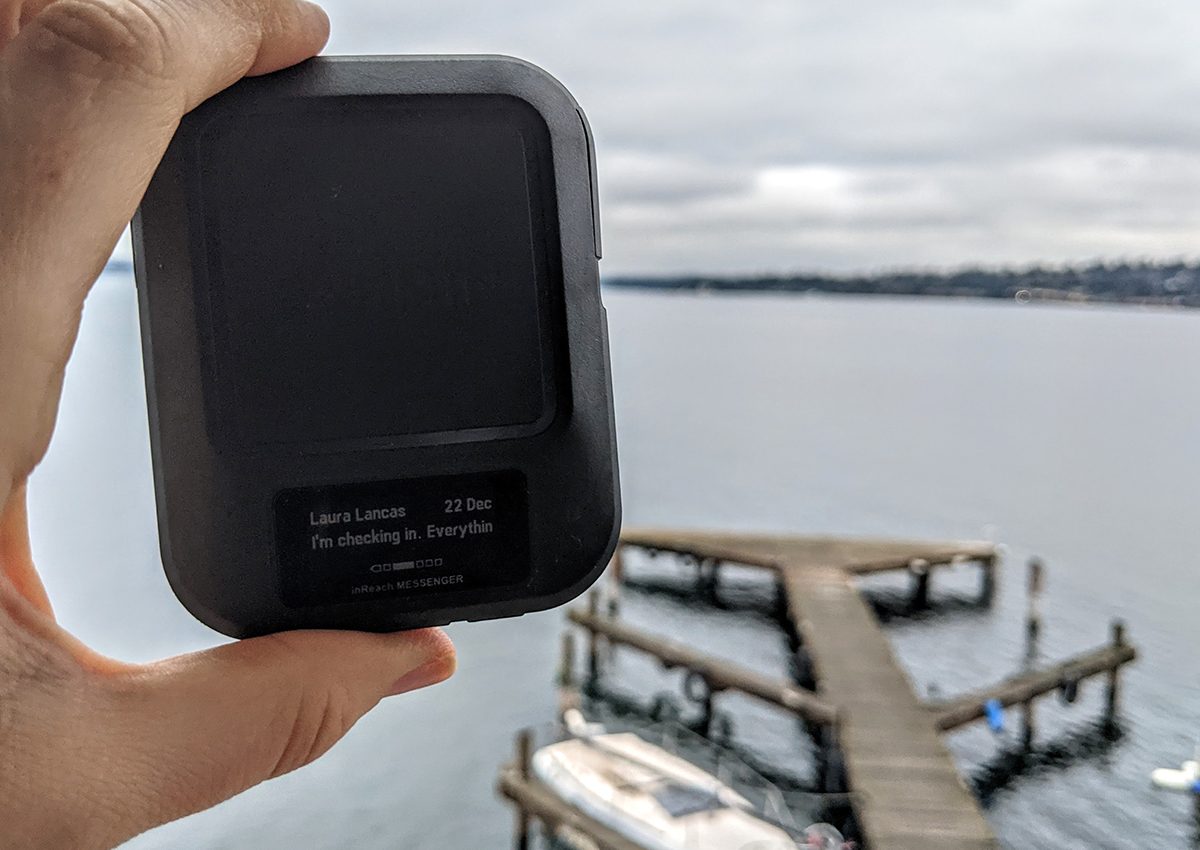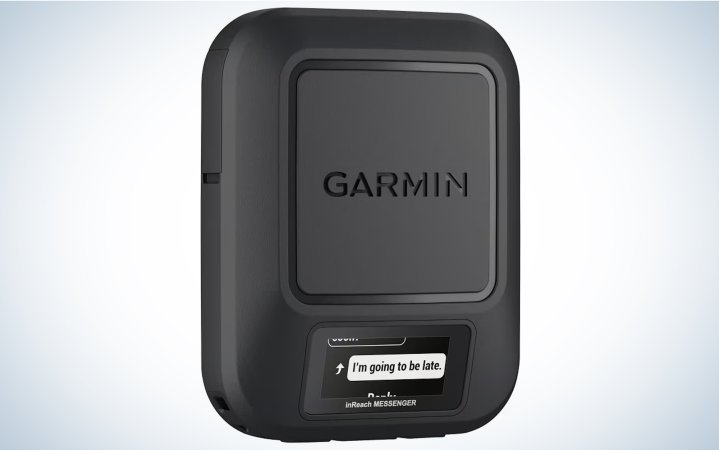We may earn revenue from the products available on this page and participate in affiliate programs. Learn More ›
The rise of satellite messengers might be one of the biggest changes in outdoor gear over the last decade. As the cost and weight of these devices came down, they’ve taken over as a must-have piece of safety gear for both serious adventurers and weekend warriors.
Along with the SPOT satellite messengers, the inReach series—particularly the inReach Mini 2—led the way in this revolution, and they are still some of the most popular models on the market. The newest addition to the inReach series is the Garmin inReach Messenger. I put it to the test over several months in a variety of environments to see how it stacks up against the competition.
Garmin inReach Messenger Specs and Features
- Weight: 4 ounces
- Dimensions: 3.1 inches x 2.5 inches x .9 inches
- Pairing: Smartphones, smartwatches
- Battery: Rechargeable lithium-ion, built-in
- Battery Capacity: 1,800 mAh
- Charging Port: USB Type C
- Water Resistance: IPX7 (up to 1 meter for 30 minutes)
- Satellite Network: Iridium
- Communication Type: Preset messages, custom text messages, location sharing, emergency SOS
| Device | PLB or satellite messenger | Weight (ounces) | Screen | Max battery life | Satellite network |
| Garmin Messenger | Satellite mess. | 4 | Yes | 28 days | Iridium |
| Garmin inReach Mini 2 | Satellite mess. | 3.5 | Yes, GPS | 14 days | Iridium |
| Garmin inReach Explorer+ | Satellite mess. | 7.5 | Yes, GPS | 4 days | Iridium |
| ZOLEO | Satellite mess. (requires smartphone) | 5.3 | No | 8 days | Iridium |
| Somewear Global Hotspot | Satellite mess. (requires smartphone) | 4 | No | 10 days | Iridium |
| ACR ResQLink View | PLB | 5.3 | No | 5 years | COSPAS-SARSAT |
| SPOT Gen4 | PLB (limited messaging) | 5 | No | 4 AAA lithium | Globalstar |
Battery
The biggest and most important differentiator with the Garmin Messenger is its battery. While the device only weighs a ½ ounce more than the Mini 2, its battery has twice the oomph—capable of lasting for up to 28 days under ideal conditions. It’s such a large battery that you can charge other devices from the Messenger (although this is not something OL or Garmin would recommend).
New App
Garmin also updated their smartphone app with the release of the messenger, making it significantly more intuitive to use. It’s now comparable to the Zoleo and Somewear apps. Like these other apps, its user interface focuses on messaging and weather updates. It’ll look and feel like other popular messaging apps, and will even pull in your contacts directly from your phone. Definitely take the time to sync up the app to your Garmin inReach Messenger before heading out into the field as this is by far the easiest way to use the messaging function.
Testing the Garmin inReach Messenger in the Field
Looking at the specs for the Garmin inReach Messenger, what I was most interested in was the battery claim. It has twice the Garmin inReach Mini 2’s battery life for only a 1/2 ounce more weight. To put the battery to the test, I fully charged both the Messenger and the inReach Mini and left them outside to see how long it would take to drain them.
The units were subjected to overnight temps below freezing (cold is murder on battery life). The battery of my inReach Mini (an older model, but one that has been minimally charged and recharged) died in 36 hours. The inReach Messenger lasted nine days.
In addition to putting the battery life through its paces, I also checked ease of setup, features, and messaging functionality, both via the app and on the device directly. I then compared it to my prior experiences using the Garmin inReach Mini, SPOT satellite messenger, and Somewear.
Messaging


Like other devices in the inReach family, the Messenger allows individuals to communicate with contacts in the frontcountry via satellite text messages. Unlike other devices in the Garmin inReach family, this is basically all it does. While its small screen (and complete lack of a built-in keyboard) does make this slightly more difficult than with other models, individuals looking for a pure satellite messenger that can go the distance on longer treks will find that this has plenty of features for their purposes.
What the Garmin inReach Messenger Does Best
The Garmin inReach Messenger has a great battery. If you are tired of checking and double-checking that you’re not inadvertently chewing through the battery of your satellite messenger, then this is the pick for you. For some users, who are already carrying a power bank to compensate for the limited battery of their smartphone, this is less important, but for backpackers and backpack hunters serious about cutting their base weight, one less electronic to account for is an important benefit.
The updated app for the Garmin Messenger makes the experience of sending and receiving messages via your smartphone nearly as intuitive as any other messaging app—at least on your end. (Be sure to warn your contacts that they’ll be receiving a text message from an unknown number, however, as it may otherwise be deleted as spam.) And if you already own a Garmin inReach product, good news, the app can be paired with your existing satellite messenger.
For those whose journeys are lasting a hair longer than expected, the ability to pull up a general weather forecast is helpful. For the cost of a text message (the cheapest plan comes with 10 free text messages, with each additional text message costing an extra fifty cents) you can get a detailed look at the next 24 hours and a general sense of the next four days. While I wish the weather forecast information provided more detail, this will help backpackers make smart decisions about how to handle inclement weather events.
Finally, like all of Garmin’s inReach products, the Messenger uses the Iridium network for its satellite coverage. While not as extensive as the coverage provided by the netowrk used by SAR, Cospas-Sarsat, the Iridium network does provide more coverage than the next closest competitor, GlobalStar (Cospas-Sarsat does not support satellite messengers). Last year Garmin hit 10,000 SOS messages on this network; find out here what patterns we can draw from backcountry emergency requests.
Where the Garmin inReach Messenger Can Improve

Like the Garmin inReach Mini 2, the Messenger does not have a built-in keyboard. This means that if something happens to your smartphone while out in the backcountry, at some point you’ll probably have to laboriously input each message, letter by letter, to send out anything that’s not loaded as a preset message. Fortunately, Garmin provides you with 10 preset messages, as well as the ability to customize them to whatever you think will be most useful (Strangely, “Trip went south; bring beer and pick me up at these coordinates.” isn’t included as a starter preset message.). This functionality puts it several notches above something like the Spot Gen4, and just a hair below the ease of using the Mini 2.
Like the Garmin inReach Mini 2, the Messenger has a TracBack function. When the inReach Messenger is powered on and connected to satellites, it automatically records its location every 10 minutes to create a hidden trip log in the background. However, it’s doubtful that backpackers will get much use out of this without the inclusion of at least the breadcrumb map and built-in compass. Instead, you get “203 feet NE.” It’s not nothing, but for people used to following a line on a map, it’s a bit like trying to follow the prompts of a text-based game. (The messenger app also does not provide a map to follow.)
In general, the cost of the Garmin inReach Messenger (and most satellite messengers, for that matter) can be a major limiting factor. While the Messenger itself retails for $100 less than the inReach Mini 2 ($300 versus $400), the plans themselves are where the real costs come in. A $30 annual fee along with a monthly cost starting at $15. Even if you only kept your inReach active for four months a year you’d still rack up $450 in charges over five years. If you’re only purchasing a device for the SOS function, you’re much better off with one of the best personal locator beacons like the ACR ResQLink 400.
Final Thoughts
While the Garmin inReach Messenger is unlikely to dethrone the Garmin inReach Mini 2 for backpackers and backpack hunters anytime soon, its robust battery makes it an excellent option for individuals heading into the backcountry for weeks at a time. The slightly lower price point may also appeal to individuals who have been putting off purchasing a Mini 2, thinking they don’t need quite that level of tech. Finally, all Garmin inReach users should make time before their next trip to download the updated app, which provides an improved and seamless texting experience.

